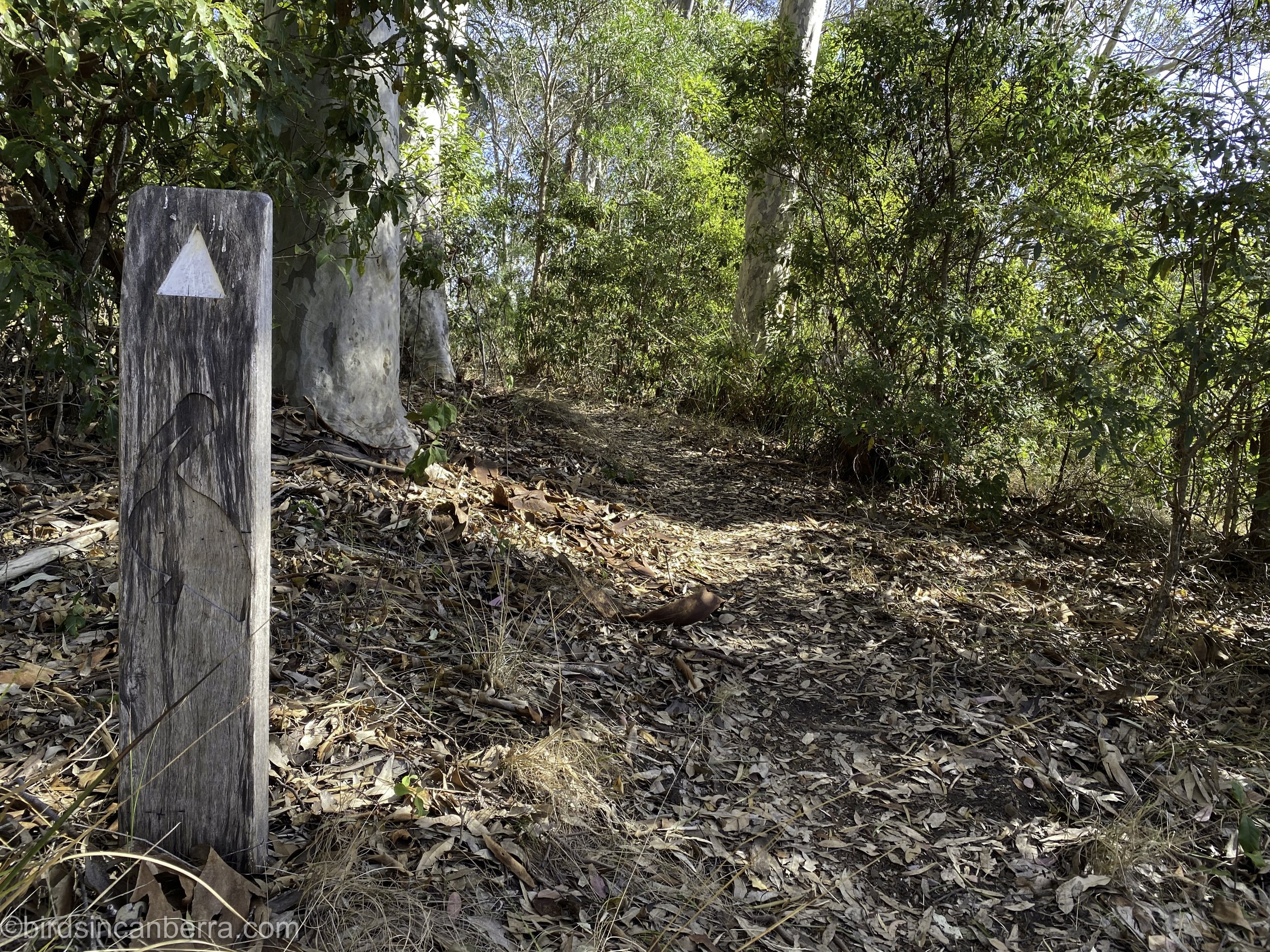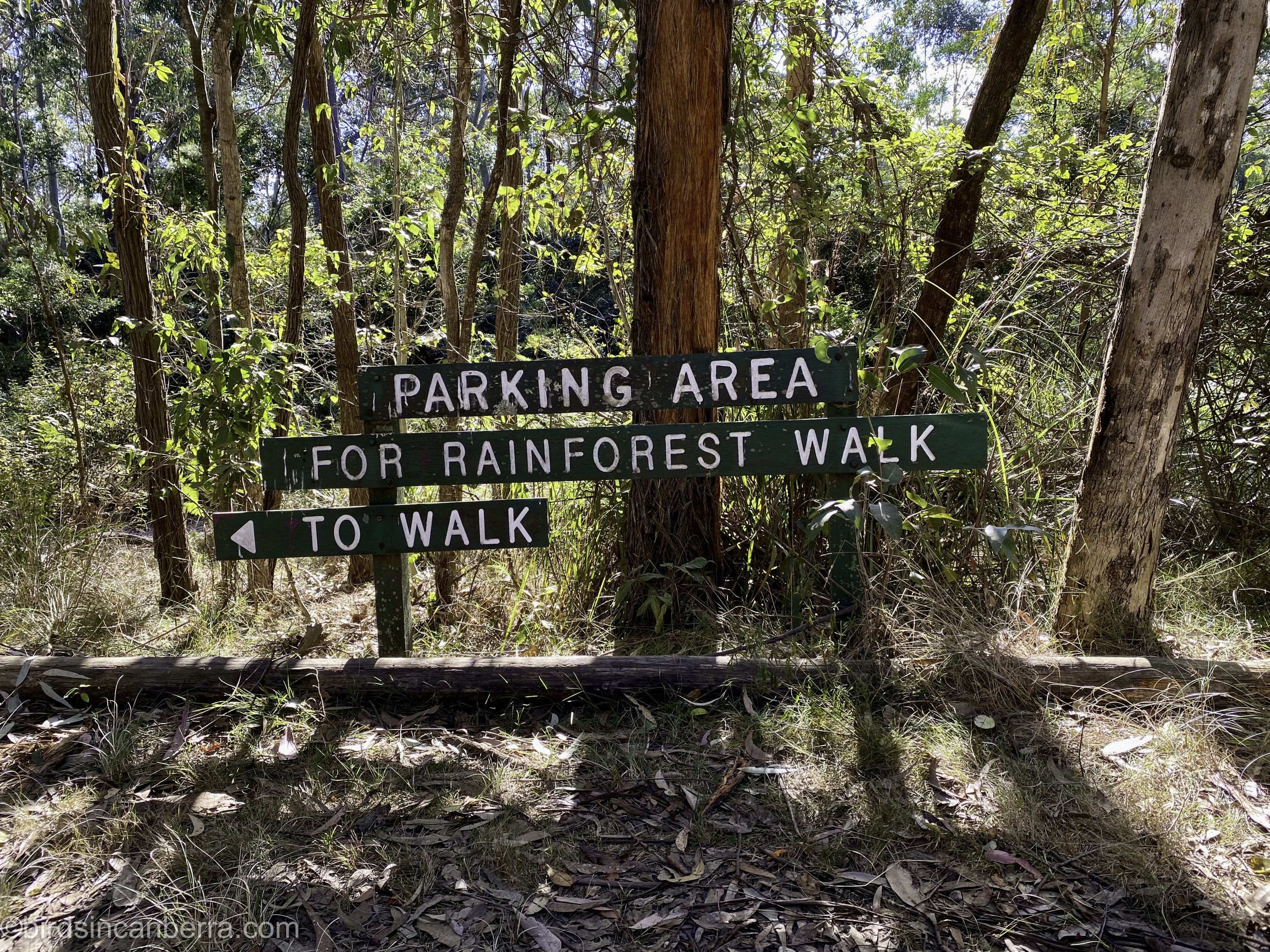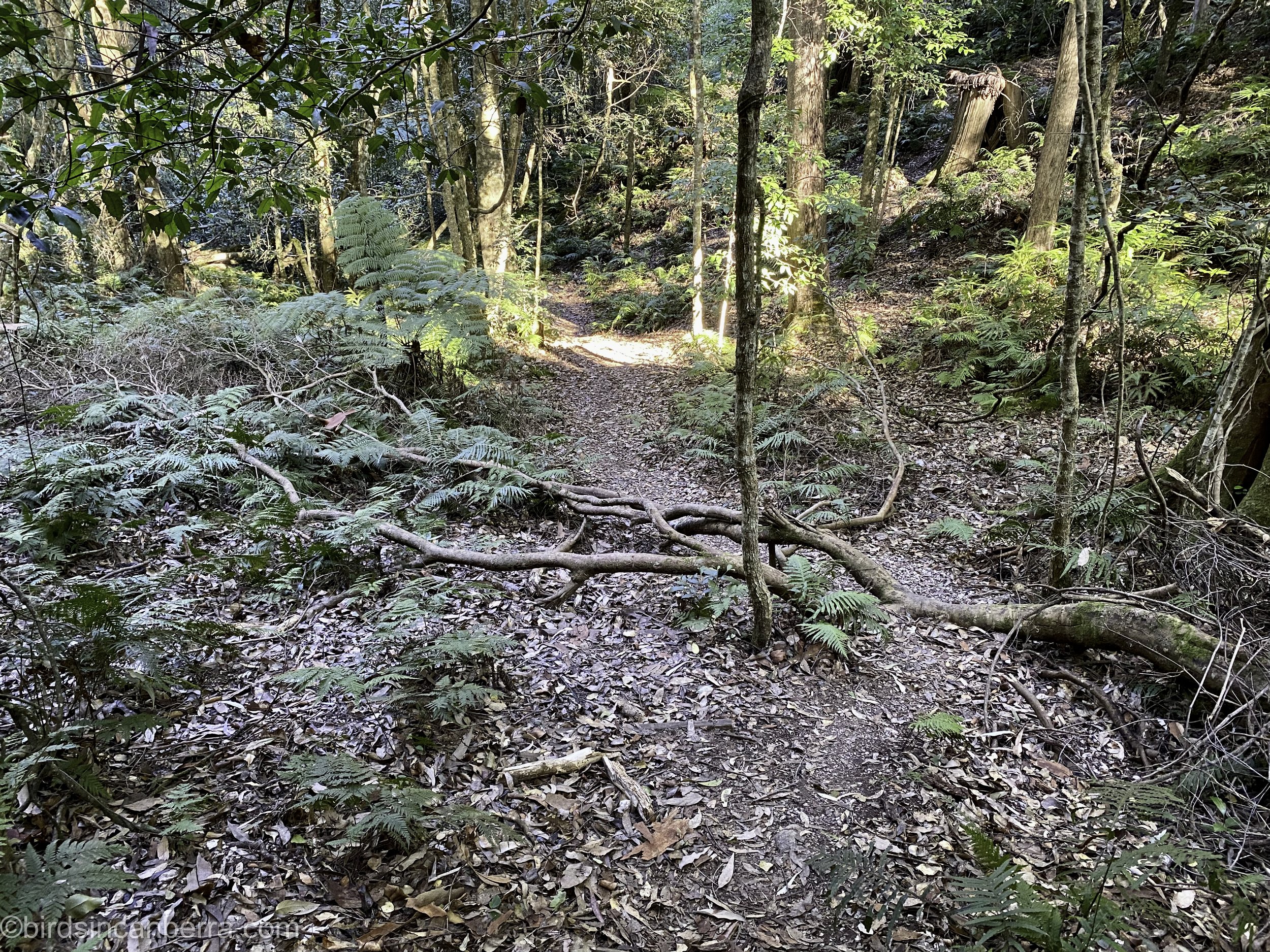Narooma continues to hold appeal, especially as a welcoming place to escape some of Canberra’s winter cold. Spending a week in Narooma meant that there was time explore around the area a bit more. One location worth exploring was on the way back to Canberra, at the Wray Street Oyster Shed right on the bank of the Clyde River at Batemans Bay. In the water beside the blue-painted shed there was a mixed group of ducks swimming not far from the shore. Among the ducks were Chestnut Teals, including a number of males with their wonderful dark green heads that shimmer in the light. Unfortunately, the teals were swimming in the shadow so the intense colours were not obvious. These birds are very common on calmer, estuarine waters near the coast and they have such wonderful colours. I always enjoy photographing them and I hope that you enjoy the photographs below.
As part of the exploring, early one morning I undertook the roughly 40km loop riding the Wagonga Scenic Drive that effectively circled around the Wagonga Inlet. It was a peaceful experience where much of the ride was along fire trails through coastal forest. Following the route counter-clockwise meant the return to Narooma township edges along the southern side of the inlet. By following unofficial foot pads it was possible to mainly avoid roads and stay right beside the water. That was how I came across the tranquil morning scenes below. The sailing boat without a mast moored like a convenient roost for birds just off the shore of the inlet. The tyres carefully laid from the shore out into the inlet that would serve as a walkway for a person to avoid getting stuck in mud when getting in or out of a small boat or kayak.
South shore of Wagonga Inlet
(Canon EOS 6D Mk II with a Canon EF70-200mm f/4L IS II USM [ISO 500, 171mm, f/11 and 1/200 SEC])
Unofficial wharf on the southern shore of Wagonga Inlet
(Canon EOS 6D Mk II with a Canon EF70-200mm f/4L IS II USM [ISO 500, 74mm, f/11 and 1/125 SEC])
Also on the southern side of the inlet, just on the western edge of the town is the Ringlands Walk that follows the shoreline. The sign advising that the walk is 3.3 km long is a little misleading because that is the one-way distance, so to get back to where the carpark is walkers have to return back the way they have come. Meaning that the walk is actually 6.6 km. Still, it was a nice walk and it follows the shore of the inlet. There were a lot of birds along the walk and even a snake. Definitely something to do when in Narooma but be sure to take water, especially in Summer and wear shoes that have good grip and are comfortable to walk over slightly uneven ground.
Along the walk, a White-faced Heron (Egretta novaehollandiae) was slowly stalking through the mangrove roots in the shallows.
White-faced Heron stalking the mangrove edge
(Canon EOS 6D Mk II with a Canon EF100-400mm f4.5-5.6L IS II USM [ISO 200, 400mm, f/7.1 and 1/400 SEC])
Unfortunately, because the walk was on the south side of the inlet I was shooting into the sun most of the time. However, I did like the silhouetted shot of the Australasian Darter (Anhinga novaehollandiae), where the sun was lighting the areas of thin feather overlap. The bird had also created a nice symmetry with its outspread wings.
Australasian Darter silhouette against the morning’s rising sun
(Canon EOS 6D Mk II with a Canon EF100-400mm f4.5-5.6L IS II USM [ISO 100, 400mm, f/8.0 and 1/400 SEC])
Walking back along the trail there was a 1.5 m long Red-bellied Black Snake (Pseudechis porphyriacus) off to the side. It was lying very still and I almost waked right past it before I noticed its long black body stretched out in the grass. Once I was aware of it I was very excited because I have so rarely seen snakes in the wild when I have had my camera with me. I quickly laid down in the grass to get some eye-level shots. Only after lying down did I realise that I had placed myself within arms reach of the snake’s rear half and tail. I could understand why the snake was starting to flatten its neck in a sign of agitation because I must have looked like a very large threat that was taking an interest in it. After taking some photographs I stood up and walked past the snake to give it some room. After a few moments the snake must have realised that I was not coming back and it curved around to diagonally cross the trail away from where I had just passed. Somewhat surprisingly, it slid reasonably quickly but its body was almost straight, with just minor curves giving the impression that nothing was propelling it. It was amazing to see this wonderful animal so close with its lovely black body and obvious red under belly. I never felt threatened by it and I was amazed how it was able to move so smoothly but rapidly when it departed.
Red-bellied Black Snake flattening its neck as a sign of agitation
(Canon EOS 6D Mk II with a Canon EF100-400mm f4.5-5.6L IS II USM [ISO 400, 340mm, f/8.0 and 1/500 SEC])
Returning back almost to the start of the trail I walked through an area of very close trees that created almost a tunnel over the path. The area was alive with bird calls and small shapes flitted between the ground and the branches. It was like a small-bird walkway. The interlocking canopy blocked the light from the area so even though it was the middle of the day the light struggled to make it down to where the small birds were moving.
A lone Silvereye (Zosterops lateralis) was flying between trees on both sides of the path.
Silvereye
(Canon EOS 6D Mk II with a Canon EF100-400mm f4.5-5.6L IS II USM [ISO 1000, 400mm, f/7.1 and 1/400 SEC])
The most interesting bird that I saw was a common Eastern Yellow Robin (Eopsaltria australis) but it had a broken beak. The top half of its beak was bent upwards but the bird looked to be fine beyond that. It was apparently doing well at gathering food to get enough energy.
Eastern Yellow Robin surviving despite its up-turned top beak
(Canon EOS 6D Mk II with a Canon EF100-400mm f4.5-5.6L IS II USM [ISO 1600, 400mm, f/7.1 and 1/400 SEC])
At least one White-browed Scrubwren (Sericornis frontalis) was moving through the low undergrowth, where the ambient light was even darker making photography more challenging.
White-browed Scrubwren
(Canon EOS 6D Mk II with a Canon EF100-400mm f4.5-5.6L IS II USM [ISO 1600, 400mm, f/7.1 and 1/400 SEC])
Just north of Narooma, in the state forest exists the short Rainforest walk. This walk had an obvious car park with a sign pointing people to the start of the walk. At the start there was an information board before the path descended down into the temperate rainforest. It was so tranquil and quiet among the trees and ferns. A number of birds were calling but it was impossible to see them. The path wound its way through close-growing undergrowth but it was always easy to follow. The walk was only around a kilometre and it was an enjoyable way to spend some time.
The very low light below the canopy made it hard to take photos but I did photograph this lichen covered, twisted vine.
Lichen-covered twisted vines
(Canon EOS 6D Mk II with a Canon EF100-400mm f4.5-5.6L IS II USM [ISO 2000, 100mm, f/8.0 and 1/50 SEC])
Lewis Island is always a nice place to visit. It sits on the north shore of the Wagonga Inlet, protecting a small, quiet bay behind it where wading birds and cormorants come to search for food.
On the island a dead mangrove tree trunk caught my eye, it was by itself facing the inlet. Despite being dead its lower trunk still provided a good home to many oysters.
A dead mangrove still providing a firm base for oysters
(Canon EOS 6D Mk II with a Canon EF100-400mm f4.5-5.6L IS II USM [ISO 100, 158mm, f/8.0 and 1/400 SEC])
A Sacred Kingfisher (Todiramphus sanctus) used the tightly packed mangroves to keep its distance. It was flying through the trees while the tide was dropping because it was probably not good hunting conditions with such shallow water.
Sacred Kingfisher trying to go unnoticed in the mangroves
(Canon EOS 6D Mk II with a Canon EF100-400mm f4.5-5.6L IS II USM [ISO 500, 400mm, f/8.0 and 1/400 SEC])
A pair of Azure Kingfishers (Ceyx azureus) were on the edge of mangroves when the tide was rising. The shallow clear water probably made it easy for them to spot prey while the thickly growing mangroves provided good cover for them.
Azure Kingfisher trying to avoid me
(Canon EOS 6D Mk II with a Canon EF100-400mm f4.5-5.6L IS II USM [ISO 3200, 400mm, f/8.0 and 1/400 SEC])
Over a number of days a group of Royal Spoonbills (Platalea regia) were regularly wading through the shallows behind Lewis Island. Their clear, white plumage brightly reflecting the sun making their presence obvious. One afternoon I dashed down to try and photograph the group but they were mainly gone, with just a single bird slowly moving through the narrow passage between the shore and the island. The spoonbill didn’t have its bill in the water and once it saw me it took off. The genera name Platalea was probably coined by Cicero in Ancient Rome and was formally made its scientific name by the person who created the modern taxonomic approach, Carl Linnaeus. It is a pretty easy name to give once the bill is seen.
Royal Spoonbill in the shallows near the mangroves
(Canon EOS 6D Mk II with a Canon EF100-400mm f4.5-5.6L IS II USM [ISO 400, 400mm, f/8.0 and 1/400 SEC])
There were not just water birds on Lewis Island. One day a Willie Wagtail (Rhipidura leucophrys) took a break from hunting insects by resting on the railing of the foot bridge that led to the island.
Willie Wagtail on the bridge railing to Lewis Island
(Canon EOS 6D Mk II with a Canon EF100-400mm f4.5-5.6L IS II USM [ISO 400, 400mm, f/8.0 and 1/400 SEC])
Beyond the Lewis Island there are certainly other places around Narooma that had active birds even in winter.
One windy morning paddling west along the inlet the wind gusts were making kayaking less than enjoyable. Because of the strong gusts I turned into a little bay that had an active oyster lease. On the shoreline there was a dead tree with Little Pied Cormorants (Microcarbo melanoleucos) perched throughout it. Despite cormorants being usually very skittish, these birds stayed on the tree while I photographed them.
Little Pied Cormorants perched on a dead tree
(Canon EOS 6D Mk II with a Canon EF100-400mm f4.5-5.6L IS II USM [ISO 3200, 135mm, f/8.0 and 1/400 SEC])
A Crested Tern (Thalasseus bergii) was also taking advantage of the relative calm in the bay to perch on a oyster lease sign.
Crested Tern
(Canon EOS 6D Mk II with a Canon EF100-400mm f4.5-5.6L IS II USM [ISO 3200, 400mm, f/8.0 and 1/400 SEC])
Back on land, a group of juvenile Crimson Rosellas (Platycercus elegans) were enjoying plucking the buds off a tree that was on the cusp of blooming. I tried to zoom in on a single bird that was not obscured by branches.
Crimson Rosella juvenile
(Canon EOS 6D Mk II with a Canon EF100-400mm f4.5-5.6L IS II USM [ISO 1600, 400mm, f/8.0 and 1/400 SEC])
A lone White-faced Heron (Egretta novaehollandiae) was looking for food on boat decks and a wharf. The tide was high while it was there so it was not able to walk in the shallows. At one stage it spied sone food but the water depth was too great to catch the fish.
White-faced Heron on a wharf
(Canon EOS 6D Mk II with a Canon EF100-400mm f4.5-5.6L IS II USM [ISO 400, 400mm, f/8.0 and 1/400 SEC])
Going further north from Narooma, a wonderful spot to stop before taking the Kings Highway back to Canberra was at the Wray Street Oyster Shed. It was quietly tucked away on a dead-end road beside the Clyde River. It was an easy stop on the return trip to Canberra because it was a left turn on the second roundabout once on the Kings Highway then follow the road to the right that runs along the bank of the river.
Wray Street Oyster Shed (taken on an iPhone)
There are often ducks swimming in the Clyde River just beside the Wray Street Oyster Shed. One of the ducks swimming there was an interesting Pacific Black Duck x Mallard hybrid. Even though the mallard is an introduced bird it is similar enough to the native Pacific Black Duck that it can breed with the native bird. Both species of ducks live in similar habitats. The hybridisation is spreading in Australia and genetically pure communities of the native Pacific Black Duck may become rarer in the future if the hybrid ducks continue moving to new areas. The up-curved tail feather was a clear indicator of a hybrid.
Pacific Black Duck x Mallard hybrid male
(Canon EOS 6D Mk II with a Canon EF100-400mm f4.5-5.6L IS II USM [ISO 1600, 100mm, f/8.0 and 1/500 SEC])
There were several Chestnut Teals (Anas castanea) including at least one male, who was swimming the closest to the oyster shed. Unfortunately, the bird was swimming in the shadow of the shed so the sun was not able to light up the teal’s gloriously green head plumage.
Male Chestnut Teal
(Canon EOS 6D Mk II with a Canon EF100-400mm f4.5-5.6L IS II USM [ISO 1600, 371mm, f/8.0 and 1/500 SEC])
In was interesting have an extended stay in Narooma over winter and seeing more of what is around the township as well as what birds live there throughout the winter. As I write these words spring is upon us, with the days warming up and getting longer. It will be good to cast off another another cold Canberra winter to enjoy the coming of new life and more activity in spring. However, it was nice in winter to see that there were still interesting subjects to photograph in the coastal town of Narooma.
Thanks for reading this post and thanks also for looking at my photos. I hope you come back again to read more about some of the wonderful natural things that the south coast of New South Wales has on offer. All the best until the next post.









